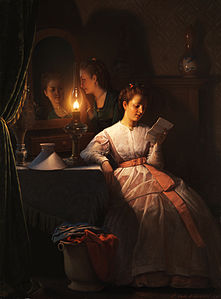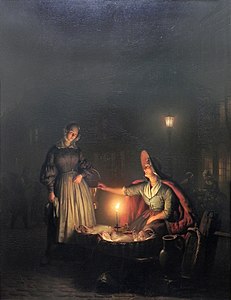Biography
On the advice of a family friend, who was a retired army officer, his father sent him to study at the Royal Academy of Fine Arts in Antwerp. He studied there from 1822 to 1828 with the history painter Mattheus Ignatius van Bree, and received a gold medal for "Perspective" upon graduating.
He made a name as a portrait painter and moved frequently, living in Breda (1828-1829), Amsterdam (1830-1832), Rotterdam (1832-1838), and The Hague (1838-1845). He was a regular participant in the Exhibition of Living Masters and the various "Triennial Salons" of Antwerp, Brussels and Ghent. In 1834, he was named a member of the Royal Academy of Fine Arts in Amsterdam.
In 1845, he settled permanently in Brussels. His studio there was divided into a well-lighted space where he actually painted, and a darkened space where his models posed. He won several medals at expositions in Paris and London during the late 1840s. Some of his works were bought by King Leopold I. He also published course books on perspective and facial expression.
He painted Biblical scenes and landscapes, lit by the moon, as well as his genre works and traditional portraits. Many of his paintings were also done as ink wash drawings and made into woodcuts. In 1869, he created a few experimental paintings lit by electric arc lamps.
In addition to his art, he was interested in the mechanics of steam engines and, in 1841, patented a device for improving the blades on steamships. He also devised suggestions for improving the lateral stability of railroad cars and reclaiming the moorlands in De Kempen.
He was married three times and had fifteen children; thirteen by his first wife, Elisabeth, who died in 1850.

Drimmelen is a municipality and a town in the southern Netherlands, in the province North Brabant.

Pieter Aertsen, called Lange Piet because of his height, was a Dutch painter in the style of Northern Mannerism. He is credited with the invention of the monumental genre scene, which combines still life and genre painting and often also includes a biblical scene in the background. He was active in his native city Amsterdam but also worked for a long period in Antwerp, then the centre of artistic life in the Netherlands.
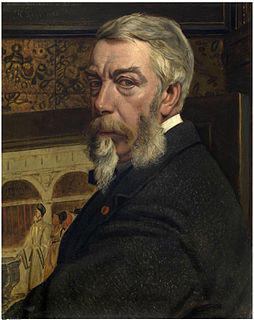
Henri Leys, Hendrik Leys or Jan August Hendrik, Baron Leys was a Belgian painter and printmaker. He was a leading representative of the historical or Romantic school in Belgian art and became a pioneer of the Realist movement in Belgium. His history and genre paintings and portraits earned him a European-wide reputation and his style was influential on artists in and outside Belgium.

Petrus Christus was an Early Netherlandish painter active in Bruges from 1444, where, along with Hans Memling, he became the leading painter after the death of Jan van Eyck. He was influenced by van Eyck and Rogier van der Weyden and is noted for his innovations with linear perspective and a meticulous technique which seems derived from miniatures and manuscript illumination. Today, some 30 works are confidently attributed to him. The best known include the Portrait of a Carthusian (1446) and Portrait of a Young Girl ; both are highly innovative in the presentation of the figure against detailed, rather than flat, backgrounds.

Antoine Joseph Wiertz was a Belgian romantic painter and sculptor.

Jan Willem Pieneman was a painter from the Northern Netherlands.

Willem Adriaensz Key was a Flemish Renaissance painter.

Louis-Marie Autissier, was a French-born Belgian portrait miniature painter. According to Marjorie E. Wieseman, curator of European painting, at the Cincinnati Art Museum, "Autissier's success as a miniaturist was in large measure due to his talent as a colourist and his meticulous detailing of costumes and accessory." He is considered the founder of the Belgian school of miniature painting in the nineteenth century. Among his most accomplished pupils and followers were Alexandre Delatour (1780—1858), Louis Henry Fontenay (1800—1852), and Dominique Ducaju (1802—1867). His works are in the collections of the Cincinnati Art Museum, the Nationalmuseum and the Royal Collection.

Charles Emmanuel Biset or Karel Emmanuel Biset was a Flemish painter who had a peripatetic career working in various cities and countries including his hometown Mechelen, Paris, Annonay, Brussels, Antwerp and Breda. He worked in many genres including genre scenes of interiors with merry companies and gallery paintings, history painting, still life and portraiture.

Ferdinand de Braekeleer, sometimes spelled as Ferdinand de Braeckeleer, was a Flemish painter and printmaker. He is known for his paintings of genre scenes, church interiors, historic events, religious scenes, cityscapes, market scenes and market still lifes. He is called 'the Elder' to distinguish him from his son with the same name, who was also a painter.

Petrus Kiers was a Dutch painter, graphic artist and photographer. He created portraits, still-lifes and cityscapes, but he is best known for his genre scenes, lit by lamps or candles.

The depiction of night in paintings is common in Western art. Paintings that feature a night scene as the theme may be religious or history paintings, genre scenes, portraits, landscapes, or other subject types. Some artworks involve religious or fantasy topics using the quality of dim night light to create mysterious atmospheres. The source of illumination in a night scene—whether it is the moon or an artificial light source—may be depicted directly, or it may be implied by the character and coloration of the light that reflects from the subjects depicted.

Joseph Henri François Van Lerius was a Belgian painter in the Romantic-Historical style.

Josephus Laurentius Dyckmans or Jozef Laurent Dyckmans was a Belgian painter mainly of genre scenes and portraits whose painstakingly detailed pictures earned him the nickname 'The Belgian Gerard Dou'.

Jean Pierre François Lamorinière, Jan Pieter Frans Lamorinière or François Lamorinière was a Belgian landscape painter best known for his realistic depictions of landscapes in his home country. His work is situated between the previous generation of the Romantic landscape painters and the Realist landscape.
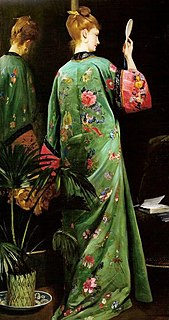
Louis-Charles Verwée or Louis Charles Verwee was a Belgian painter known for his interior scenes, genre scenes and glamorous society portraits. His genre scenes show romantic intrigues and young society ladies.
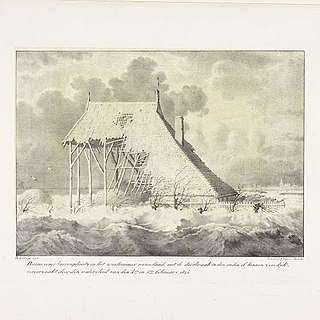
Douwe de Hoop was a Dutch painter and draftsman.
This page is based on this
Wikipedia article Text is available under the
CC BY-SA 4.0 license; additional terms may apply.
Images, videos and audio are available under their respective licenses.

